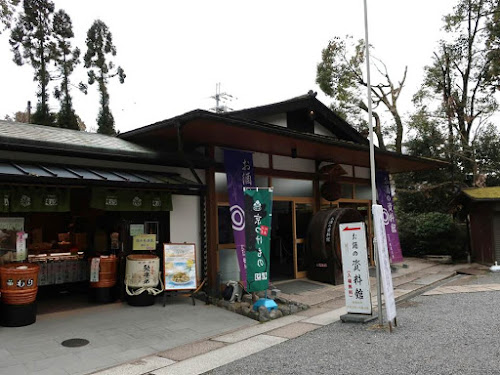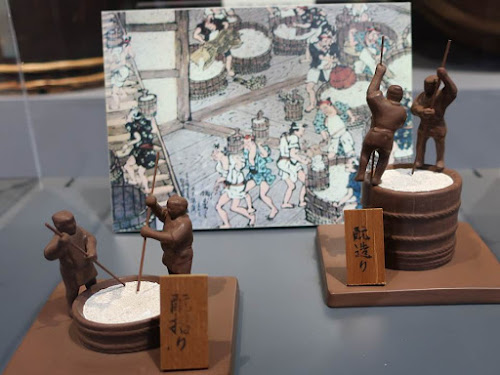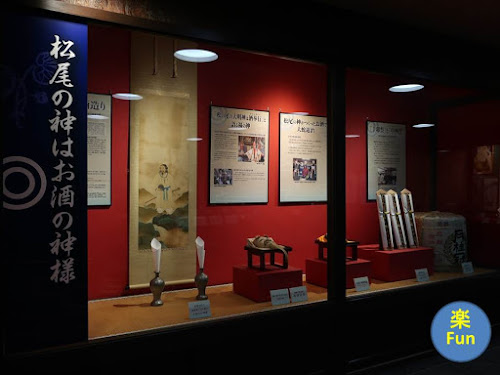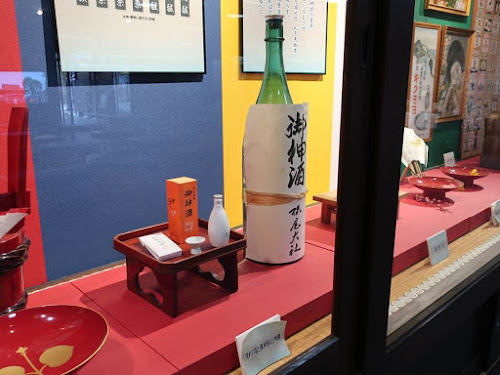This
museum shows us a Shinto ritual concerning sake, the role of sake in our daily
life, tableware for sake and manufacturing process of sake, so sake lovers
enjoy this place. “Sake = Fun” is an established formula, but some people drink out of desperation sometimes as you know.
京都の西、いわゆる洛西にある松尾(まつのお)大社鳥居前の看板には「洛西総氏神、醸造祖神、交通安全守護神」と書かれた看板があり、「日本第一酒造の神」と書かれた石柱が奉納されている。その境内にお酒の資料館がある。お酒にまつわる神事から、折々の暮らしの中での酒の役割、酒器、酒の造り方が展示されていて、酒好きにとっては楽しい資料館だ。酒を飲む=楽しむ、という図式は崩れないと思う。ヤケ酒もあるけどね。
 |
| Katsura River and a red tori gate of Matsunoo Shrine 桂川越しに松尾大社の社殿と洛西の山を望む |
 |
| Tori gate of Matsunoo Taisha Shrine |
 |
| Roumon gate、楼門 |
 |
| Stage for dancing and main hall、舞殿と本堂 |
 |
| Many sake barrels are offered which includes one of my favorite brands, “Drunken Whale” |
 |
| Museum and pickled vegetable shop are in the same building 資料館は漬物屋さんと併設 |
 |
| Wooden fermentation tank in front of the museum 資料館入口のモニュメントの仕込み樽 |
 |
| Exhibition room is not so large、展示室 |
The first area is about Matsunoo Taisha Shrine、松尾の神はお酒の神様
Many
Gods were in trouble because there were no sake at the meeting. At that time,
the God of Matsunoo made sake only in one night. That’s why the God of Matsunoo is called “the
god of sake”. Many manufactures of sake, miso and soy source, which are fermented
products, visited this shrine in the Edo period. To visit to the shrine was a good reason to get passports easily for traveling.
 |
| The God Matsunoo、松尾大社御祭神 |
八百万の神が集まられたときに、お酒がなかったのだが、松尾の神が一晩でお酒を造ったという。江戸時代には、酒造家や味噌醤油の製造者の松尾詣でが絶えなかった。お伊勢様と同じく旅の動機かなあ。
The
photo below shows the God of happiness in the festival. He says “The God of Matsunoo
is a sake bugyou (commissioner) so you must offer sake to him first, if not, other Gods will not accept sake from you.” The God of Matsunoo has
been worshiped as the commissioner and supervisor of sake related things.
 |
| The mask of the God of Matsunoo when he shows up as an old man 翁の姿であらわれた松尾の神の面 |
上卯祭(醸造安全祈願祭)で奉納される「福の神」。酒造りは11月の上の卯之日に始め、4月の中の酉の日に完了するという。福の神は、「松尾の大明神は、神々の酒の奉行じゃよって、これへ進上申さねば、余の神々の、いっこう受け取らせられぬいやい」と語る。松尾の神は、お酒のことを司り監督する神様として、人々に信仰されていたことがうかがえる、というようなことが書いてあった。
 |
| People offer sake barrel and they are bestowed wooden talismans 奉納された酒樽と、醸造関係者に授与される守護の大木札 |
The second area is about “God, sake and people”、神とお酒と人々
Many rituals are held in shrines and people pray for rich rice
harvest. Sake which is made from rice and foods are dedicated to the God. After
the ritual, all participants join Naorai ceremony in which they eat food and
drink sake with the God who gives power to people. Sake used to be brewed in
shrines and it was an important ritual there. Those are written on the
panel.
 |
| Ritual articles、神饌用の神具 |
かつては、神社で御神酒を作っており、それは大事な儀式でもあったという。
It is written on the panel “People in
Kyoto enjoyed drinking while sakura flower viewing, being in the cool of evening breeze and the moon viewing. Sake is always with those yearly practices.” Old pictures are shown.
「江戸時代、京の人々は、お花見や夕涼み、お月見などをしながらお酒を楽しみました。こうした年中行事にもお酒は欠かせないものでした」として、花洛細見図、十二月あそひの絵が紹介されている。
 |
| Drinking during wisteria flower viewing in spring、藤見の宴 |
 |
| Wisteria flower in Ashikaga Flower Park、足利フラワーパークの藤 |
 |
| Big wisteria tree in Ashikaga Flower Park、有名な大藤棚 |
 |
| Drinking while enjoying the cool evening breeze in summer、夕涼み |
 |
| Seeing off the spirits of ancestors with burning fire in the end of Bon event 送り火 |
 |
| Moon viewing in autumn、観月 |
 |
| Ohitaki which was a ritual held in November in Kyoto area. People offered sake to the god. 御火焚(おひたき)。京都を中心に陰暦11月に行われていた行事で、火をたき、御神酒を供えたという。知らなかった。 |
Vessels for sake are exhibited; those are cool. The vessel shown
below keeps sake warm, so people brought it outside.
遊山用の「燗瓶(かんびん)」で、錫製の徳利に燗酒を詰め、保管容器に入れてお花見などに使用したという。「利休ちろり」とも呼ぶらしい。
Katakuchi
container and ochoko cups are shown below. Katakuchi was a container to pour
sake out of the barrel to the bottle originally.
片口は、もともと酒や醤油を樽から小さな容器に移すための器だったが、後に酒器として使われるようになったという。
Hisage container was used to transfer sake
from barrel like Katakuchi container originally. It would be convenient for
heavy drinkers.
提子(ひさげ)も、もともとは樽から出した酒を調子に移すための器だったが、後に直接盃に酒をつぐための酒器になった。
The
vessels and cups are offered to Matsunoo Shrine; I prefer Kyoto-ware vessel.
奉納された酒器。私の好みは新開氏が奉納した京焼。
Sake culture お酒の文化
Congratulations 祝いの酒
 |
| ”Three-Tree-Nine” ritual during a wedding ceremony、三々九度 |
 |
Apparatus for the ritual、三々九度の盃などお祝いの用具。角樽の隣は二升五合瓶で、升はマスと読めるので、「益々繁盛」(五合=半升)ということになり、開店祝いなどで使われるとのこと。これも知らなかった。
Purification 清めの酒
Sake
has a power to purify the atmosphere, so it is used in a Shintoism ritual such
as opening ceremony.
酒には祓(はら)い清める力があり、新築などの神事の時に使われる、とある。
Manner
and Moral 酒の道
This
is a talisman for a drinker. There was “Shu-dou” which was a manner to serve
sake and dishes, to drink sake, to taste sake and so on. It differed by social
class. It is written on the poster “The manner of a tea ceremony and a flower
arrangement has flourished, however the manner of sake Shu-dou became extinct.
Drinking is for relaxation and fun, but not to work on prim and proper manners.” I agree totally.
However it is written that manner is still
important. It is written on the talisman for a drinker. “Sake is herbal medicine which is given by gods. When drinking, never cause disorder, never damage
your health, never become impolite and never break the party. If you drink properly,
you can drink forever.” This is a good lesson for me. I should have bought this
talisman. In Matsuo Shrine, there are talismans for sake brewers and sake salespersons.
服酒守、ということで意味深い。室町末期に、お酒のたしなみ方を極める「酒道」が生まれたという。お酒のつぎ方、飲み方、返杯の方法、酒膳の配り方、利き酒の仕方など色々な決め事があり、公家、武家、町人それぞれの作法があったという。
酒道は廃れたが、酒は茶道や華道と異なり、「酒の道を極めていくよりも、お酒には気楽さや楽しさが求められたからでしょうか」と書かれており、全く同意見。そのあとに、「しかし、お酒の楽しみ方にも作法があります。お酒好きのためのお守り「服酒守」にはお酒を飲むときの心得が書かれています。
「酒は神授の生薬。服して心を乱さず、身体を損なわせず、礼を失わず、和を破らず。 適時適量謹んで用いざれば久しきに堪えざるべし。」
滲み入る言葉ですねえ。買っとけばよかったかな。松尾大社の社務所で買えます。他にも、酒を造る人のお守り、酒を売る人のお守りも売られています。
Annual
events and sake 年中行事と酒
We never
miss drinking sake during annual events. In the New Year’s Day, people drink
Toso-shu and pray for our safety and health. On the 3rd of March
which is a girls’ festival day or peach festival, we usually drink white
sweet sake. People also drink sake with peach blossom; this custom is based on
Chinese legend that people can live long if they drink the river water where peach blossoms float.
On
the 5th of May which is a boys' festival day, people take a bath in
which shoubu iris floats. Moreover people drink aromatic sake, in which iris floats,
to pray for safety. On the 9th of September, there is Chouyou
festival. People drink sake in which chrysanthemum floats: it gives us longevity.
Sake is tasted with seasonal plants on festival days.
年中行事には酒が付き物ということで、お正月の屠蘇酒(邪気を払い長寿を願う薬草酒)、3月3日の桃の節句には、白酒も飲むが、桃の花が流れる川の水を飲むと長寿が得られるという中国の故事にちなんで、桃の花を刻んで清酒に浮かべた桃花酒も飲んだそうだ。5月5日の端午の節句には、邪気を払う菖蒲湯に入るだけでなく、菖蒲の茎を浸した香り高い菖蒲酒も飲むという。そして、9月9日の重陽の節句。長寿をもたらすという菊酒を飲んだという。まさに、四季折々だ。
 |
| The peach festival in the Edo period、江戸時代の桃の節句/花洛細見図より |
 |
| The Chouyou festival in the Edo period、江戸時代の重陽の節句/花洛細見図より |
The
old posters for advertisement, labels of sake bottles and containers are
exhibited. 清酒の広告のポスター、ラベル、販売容器も展示されている。
How to make sake 酒造り工程
 |
| Wash rice at first、まずは洗米 |
 |
| Steam rice and make koji malt、蒸米と麹造り |
 |
| Cultivate sake yeast、酛造り/酵母を培養する酒母(酛/もと)を作る |
 |
| Brew using steamed rice, koji mald and yeast 醪仕込み/発酵して酒を造るもろみ仕込み |
 |
| Press the fermented broth、酒搾り |
Umemiya Taisha Shrine near Matsuo Taisha Shrine 近くの梅宮大社
This
shrine is also dedicated to the god of brewing, so sake barrels are set in the gate. 桂川の対岸にある梅宮大社。こちらも酒造の神様で、楼門に酒樽が掲げられている。
“Umemiya”
means plum shrine. The plum flowers are coming out when I visited in the middle
of February. 梅は咲き始め。
The garden
is picturesque. 庭園・神苑も美しい。
The main
hall is calm. 落ち着いた本殿。
16 funs(楽fun)were found. Visited in February, 2019
Official Website : http://www.matsunoo.or.jp/guide06/ (in Japanese), accessed in August,
2020
Previous post (Museum in Shiga prefecture
which is on Toukaidou high-way and next to Kyoto) :
Next post (Museum of the major sake brewery in Kobe)
:

















Comments
Post a Comment